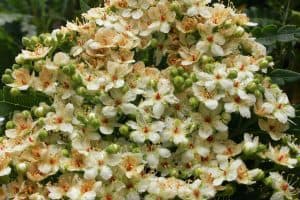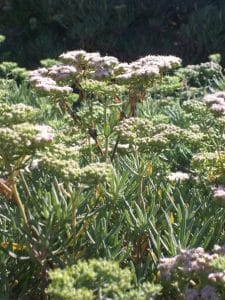Days are long, virtually no chance of rain, heat waves can be expected. Look for ideal times to apply water: cool spells, cool mornings with marine layer present, cool evenings with a breeze, cool days. Stay cool. Never water in the heat of the day. Try to soak your ground thoroughly ahead of any heat waves. Watch the forecasts, apply water when it is not blazing hot.
History/review

Spring is definitely behind us. Enjoy summer blooms, summer pollinators, magnificent evenings when the garden takes on new life and watch how tough natives can be during our normal, hot dry summer. Summer birds are here; come see the swallows at Tree of Life before they pack up and head south again.
Watering
We talk a lot about watering in this series. That’s because natives require so little water to supplement rainfall, that many people are prone to overdo it. Stick to the rule of thumb, one deep soak every 3-4 weeks May through October, light refreshing sprinkles in between. “Deep soak” means you run the sprinkler or hose end sprinkler about 30 minutes a day, three days in a row (total 90 minutes) in early mornings to thoroughly soak all the ground. “Refreshing sprinkle” in late afternoon or early evening means run the sprinkler 3-5 minutes, about 2-3 times a week… enough to wet and cool the leaves and cool the soil surface at the end of the day. Deep soak is an irrigation event. Refreshing sprinkle is not. For more detail see our watering guide here.
Pruning
Practically no pruning is necessary in summer, because the late spring pruning you (hopefully) did (see May in the Natural Garden) will promote sturdy tip growth this fall. The leaves on the plant now are shading the stems and that is good. At this point, most pruning can wait until fall.
Weeding
Always. We believe in shovels and hoes. Strengthen those abs by pulling on that sharp hoe. Contact herbicides are in overuse these days. That said, tenacious perennial weeds like nutsedge and bermudagrass are almost impossible to control without using a contact systemic herbicide. If you do spray, be very careful of volatilization, wind drift, and overspray especially in hot weather. Always pull weeds. Discard them so the seeds will not stay behind.
Mulching/Top dress
If any, your top dress mulch should already be in place. We do not recommend bringing in fresh organic mulch during hot weather. If the non mulched garden is doing fine, wait until fall to do this. If the ground is getting hot and baked, apply 2-3” coarse mulch, but keep it away from the trunks, stems and leaves of your plants, as the hot wet organic environment can cause fungi to attack the healthy tissue of your plants.
Feeding
None at this time. You can occasionally liquid feed potted plants. Wait until fall to apply fertilizer to natives in the ground. Desert plants which grow during the warm season can be fed now, according to their needs. Organic fertilizers or liquid feed, half strength will do a nice job.
Troubleshooting – Varmints, Pests and Diseases
Varmints. If you have enough plant material for both you and that family of bunnies, you have nice habitat. Unless they are very numerous, leave your bunnies alone. The hawks and owls will thank you. If the wabbits are nibbling your garden to death, call Elmer Fudd. He was the famous hunter of Bugs Bunny, for all you young folks out there. If gophers are abundant in your garden, you will need to trap them. If you get good at trapping, you can make a little purse or moccasins from their pelts. We like Maccabees traps, available at your hardware store.
Pests. Most of our warm season insect pests; aphid, scale, mealybug, leafhopper, can be controlled with insecticidal soaps or strong blasts of water from the hose. Scale insects can be controlled by wiping them off the branches, tedious job but effective, or with insecticidal oils. To the extent possible, control Argentine ant. These little guys are the ones that sometimes just show up from out of nowhere… kitchen, pantry, garage, picnic, garden plants. When the ants are on your plants, they are moving aphid, scale, mealybug, leafhopper, as they “farm” them for their benefit. They move them from branch to branch, plant to plant, and happily live off the excrement, called honeydew, a clear sticky liquid that coats the plants and stains the ground around infested plants. Ant control is tricky. You need to get the whole colony, so try growth regulators like Combat gel instead of poisons that only kill the ants they touch.
Disease. Prevent root rot by keeping your soil cool and when you water, give the ground a deep soak. It is that simple. Many disease problems are brought on by improper summer watering practices. See https://californianativeplants.com/wateringnativeplants/. Keep your soil cool, and try to maintain a consistent moisture level at 8-20” deep. Let the top 4-5” dry out between waterings.
Annual Wildflowers
If any have faded flowers and they are finished and have made seed heads, mash them up, stomp them, twist them into little bits and unless it would be too unsightly, you can leave this old dead organic matter and seed on the ground where it falls. Natural mulch. Seed will germinate this fall.
Adding New Plants
Wait til October.
Engage
Always engage. Look for Monarch butterfly cocoons. Watch the lizard run. Check out the myriad of pollinators. Trace the flight of a swallowtail, giant sulphur, or painted lady. Observe flowers turn to seed. See how the morning and evening light plays on the flowers and seed heads.
From the Garden,
Mike Evans
Questions? Help is just one call or one email away. Call (949) 728-0695 or email (with pictures if you like) our brand new help email: gardenhelp@californianativeplants.com.